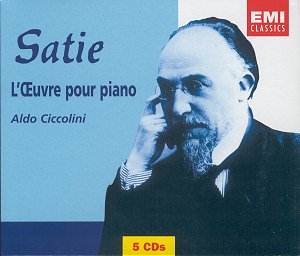This bargain-priced reissue of Erik Satie's complete piano music comes
from EMI France on five CDs, though with a little juggling of the contents
of each disc, it could have been offered on four. But no matter, since
this remains an absolute bargain anyway.
The reason that this thought is uppermost in my mind is that Satie is
very much a miniaturist. For few of the pieces collected here last longer
than a couple of minutes. Therefore it seems highly unlikely that anyone
will want to sit through all five discs one after the other. It is intended
very much as a library item, and dipping into it will give the listener
the utmost pleasure.
In fact Aldo Ciccolini recorded this repertoire is a second time during
the 1980s. However, in this splendid remastering his earlier performances
sound very well indeed, and his insights into the music and its particular
style are second to none. So this bargain-priced compilation is as near
definitive as one is likely to find.
The first disc starts with Satie's most famous music, the Trois Gymnopédies
of 1888. Their under-stated, cool fluency is marvellously conveyed by
Ciccolini, whose sense of tempo is admirable throughout the collection,
as too is his judgement of phrasing and dynamics. Of course there is a
greater musical range than these early pieces imply, and the performances
of the entertaining caf‚-style music, such as Pièce en forme de
poire or La belle excentrique, are excellent examples of the composer
in more lively and extrovert mood. On the other hand, some of the later
works, such as the Nocturnes of 1919, are somewhat intellectual in approach
and manner, altogether unconcerned with entertainment.
Having said all this, Satie's greatest musical strength remains his innate
wit, a commodity to be valued in music as in life. In this regard it is
worth observing that Ciccolini always keeps the music moving along, without
imposing undue emphasis on forced characterisation.
If the recorded sound in these remasterings has a fault, it is a tendency
towards dryness, though such a trend is not altogether inappropriate to
the musical style, of course. The piano-duet music was recorded by using
Ciccolini twice over, with the two parts dubbed together in the studio.
The natural response to this conceit is to frown upon it, but in fact
the results are successful enough. However, it is interesting to note
that when he returned to record this repertoire afresh more than a decade
later, he engaged the services of a second pianist, Gabriel Tacchino.
And quite rightly too.
This is a French issue and the insert notes come in French only. The documentation
is adequate rather than substantial, but everything is beautifully presented.
Just like Ciccolini's performances, in fact.
Terry Barfoot
|


